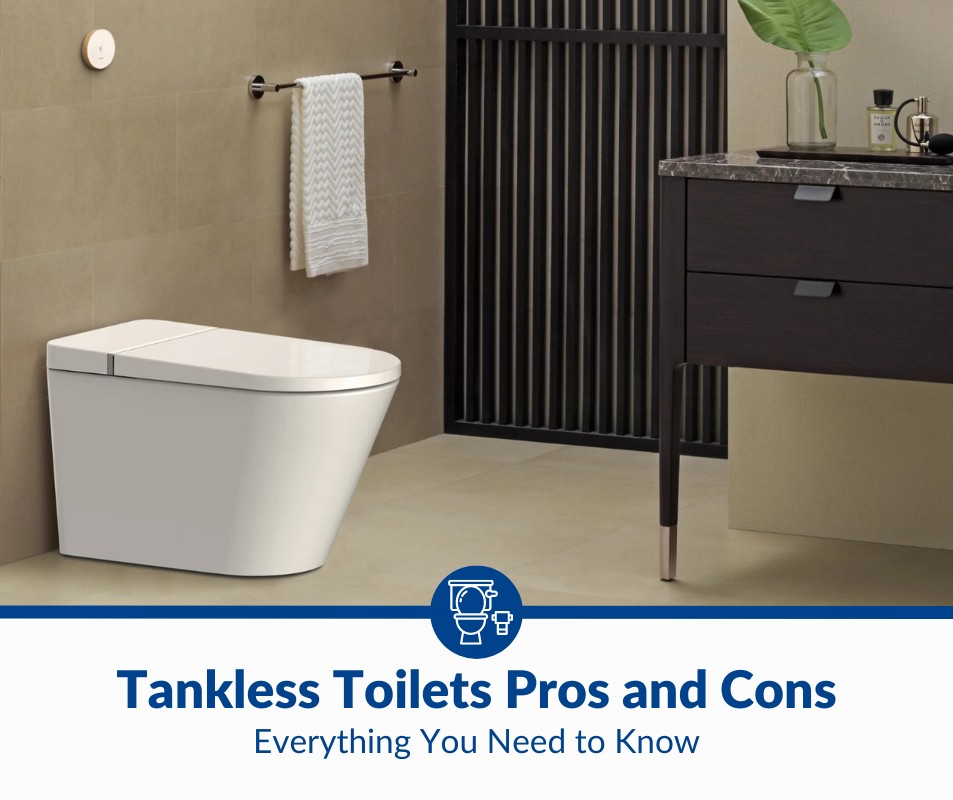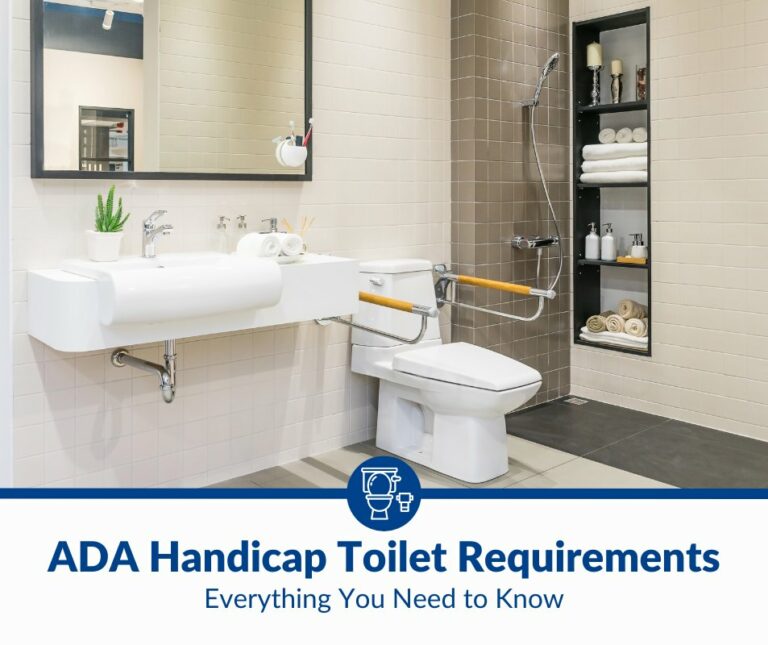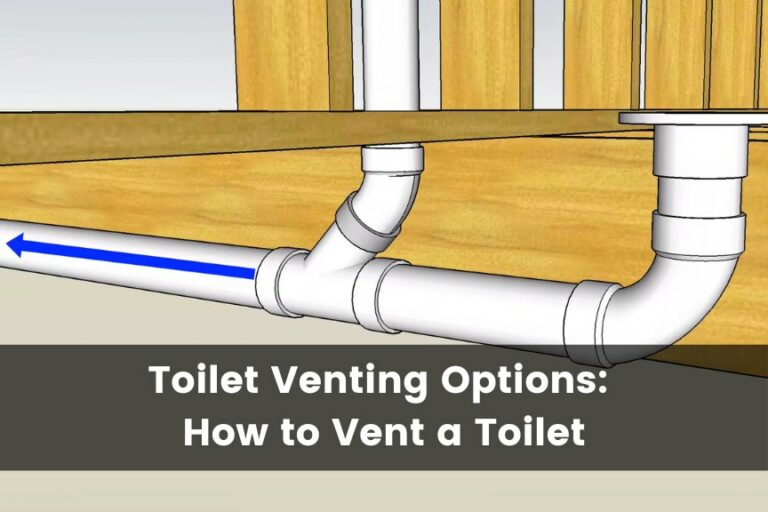Tankless Toilets Pros and Cons: Are They Good for Your Home?
According to The New York Times, bathroom renovations regularly increase a home’s resale value — and the increase is enough to cover the remodel and more. If you’re considering upgrading your bathroom, the tankless toilet is one of the less talked about toilets that can save money and reduce your environmental impact.
Tankless toilets conserve water, take up less space, offer fully customizable heights, and prevent overflows. Some have features and smart technologies to make bathrooms cleaner and more comfortable. However, these toilets are costly, require specialty installation, and require electricity.
This article explores the advantages and disadvantages of tankless toilets to help decide whether these commodes are suitable for your home. It examines the many differences between tankless and traditional toilets to help you understand why these toilets are becoming all the rage. Read on to learn more.
The Pros of Tankless Toilets
Tankless toilets have many benefits, which is why they’ve become the standard in various parts of the globe. Let’s look at several reasons homeowners are considering the switch from tank toilets to tankless toilets.
Water Conservation
Traditional toilets require water and the force of gravity to push waste from the toilet bowl into the home’s drainage system.
Tankless toilets, however, do not need excessive water to operate the toilet’s flushing function. Instead, tankless toilets utilize an electric pump to force waste through the system using pressure.
As such, these toilets don’t need a storage tank to hold water to aid in flushing the toilet. Though tankless commodes use some H2O, the amount entering the bowl when flushing is limited, which conserves water.
According to Earth Island Journal, this water conservation can reduce water costs by up to one-third.
Minimalistic Design
Since tankless toilets don’t need a large storage tank, they’re less bulky and take up less floor space than the standard one or two-piece toilets.
Their design allows them to be attached directly to the wall so that homeowners can enjoy more room. As such, these toilets are an excellent choice for small bathrooms.
Most tankless toilets also feature a simple design (save for some more expensive brands with more futuristic-looking concepts). The traditional white minimalist look fits in well with almost any bathroom decor. That said, different colors are available if you’re looking for something more customized.
Fully Customizable Height
With tankless wall-hung toilets, you can customize the toilet to fit your specific height needs.
Since they’re mounted to the wall, you can adjust them higher or lower depending on your preferences. You can even have them mounted at different heights in different bathrooms, which is especially useful for children and older adults with special needs.
Floor-mounted tank commodes are limited in height because of how they function. Most measure around 15 inches (38.1 cm) from the floor to the seat’s rim. This height is quite short for most people and may result in unnecessary bending, which strains the joints.
It’s nearly impossible to find a traditional toilet taller than the industry standard “convenient height,” which is 20 inches (50.8 cm). You’re restricted to using toilet seat risers to achieve a standard toilet taller than 20 inches when it comes to tank toilets.
No Overflow or Tank Leaks
Standard toilets rely on gravity and water to power the toilet’s flushing mechanism, so they store water in a tank for later use.
Tankless toilets do not rely on water for flushing, so there’s no need for a tank at all. Instead, the electric pump does all the work. It builds pressure that pulls waste into the pipes below. Only a limited amount of water enters the bowl, which eliminates the possibility of an overflowing toilet.
The limited use of water is a major benefit to those who have children who use too much toilet tissue and regularly clog the commode. It also makes it much easier to keep the bathroom floor clean and dry.
Not only that, but since there’s no tank, there’s no chance of water tank leaks.
In standard toilets, if the rubber flapper in the tank fails to properly seal after flushing, water continues leaking out of the tank and down the drain. The toilet attempts to refill, but the water keeps escaping. Water is continually wasted until the issue is caught, leaving the homeowner to cough up the cost. A tankless toilet prevents this, thanks to its pump and quick refill rate.
Overall, when comparing a tankless toilet vs tank toilet, the tankless toilet will come out on top, if only because it saves so much water.
Tankless Toilets Are the Future
In other countries, tankless toilets have become the standard. They’re considered more eco-friendly, comfortable, and hygienic (when equipped with additional features).
Residential tankless toilets on the market today can do more than save money and help the environment through water conservation. Today’s technological advancements have led to incredible innovations in the world of hygiene, including (but not limited to):
- Self-cleaning systems
- Anti-stain technology
- Eco-friendly antibacterial mists
- Integrated bidets
- Drying fans
Some tankless toilets come equipped with smart technology, including touchless flushing, heated seats, and night lights making them more comfortable and easier to use.
Other models of tankless toilets even go beyond the basics and offer advanced features. You can find toilets with wireless remotes, carbon-filter deodorizing fans, electrolyzed water, and foot warmers. These technologies take tankless toilets to the next level, making them a luxury investment.
The Cons of Tankless Toilets
While tankless toilets have many advantages, there are some drawbacks to consider before you go ahead and buy them for your home.
High Upfront Costs
According to Forbes, the average cost of replacing a traditional toilet is around $500 (€462.36). Some of the most basic models may be as low as $100 (€92.47), whereas more high-end standard toilets may exceed $5,000 (€4,623.60).
The price for tankless toilets is significantly higher than standard toilets, even for the simplest models.
Average prices are around $2,000 (€1,849.44), and most buyers fork out a minimum of $900 (€832.95). Some of the most expensive brands (usually tankless smart toilets with innovative technologies) go for $12,000 (€11,096.64) or more.
That said, a tankless commode is an investment, and buyers usually see a return on the investment through their home’s resale value and money saved on water costs. When a bidet and dryer are included, additional money is saved on toilet tissue.
The high costs mean that tankless toilets are best suited for those with money set aside or who are looking to upgrade and make a high-quality investment in their home.
If you are going to remodel anyway, you might want to consider if you can expand your budget to include tankless toilets. However, if you need an emergency remodel, rely on your best judgment to determine between a tankless toilet vs tank toilet.
Specialty Installation
Installation is more complicated with tankless toilets versus tank toilets. While most do-it-yourselfers can handle a standard toilet installation with little frustration, tankless toilets differ from standard toilets in many ways.
Because they don’t work the same way, bathrooms require remodeling to accommodate the new commode. At the very least, the water supply and waste lines will need to be reconfigured to fit the toilet.
A tankless toilet installation is far more complex than standard toilet installations — it’s not as simple as removing the old toilet and putting the new one in its place.
The first concern is water pressure. Generally, homes have adequate water pressure for tankless toilets, requiring between 15 to 20 pounds per square inch (psi) to flush. The valve on the toilet controls water flow and is activated using a traditional lever, button, or motion sensor.
In addition to high water pressure access, if you purchase a rear-discharge tankless toilet, you’ll have to get into the wall behind the toilet to add additional plumbing fixtures.
Some tankless toilets can mount to the floor like traditional toilets. This design can eliminate the need for heavy bathroom renovations. Pay attention to the product description to ensure you choose a model that best suits your needs.
The chances of having to hire a licensed plumber are high, which only adds to the total expenses. As such, it’s important to consider the cost of at least a partial bathroom remodel when factoring in the cost of a tankless toilet.
If you’re unsure how to proceed, reach out to a professional for a full quote.
Electric Dependent
Since most modern houses have electricity; it may not seem like much of an issue to have a toilet that depends on it.
However, it means that you’d be unable to flush your toilet during a power outage.
A power outage lasting more than a few hours could quickly lead to a problematic situation. If you can’t flush your toilet, you can’t use your toilet, which means you wouldn’t be able to stay in your home until power is restored.
Fortunately, there are many brands of tankless toilets that have backup power options using batteries.
These typically provide enough power to hold you over until power is restored to the home. Some can run for up to a month or more on a single set of batteries, giving you access to your toilet even when the power goes out.
If you’re in an area that experiences frequent power outages or storms, consider investing in one of the battery-powered tankless toilets to avoid finding yourself in a stinky situation.
Noisy Flushing
Although tankless toilets are very reliable when it comes to flushing and preventing overflows, they tend to be very noisy, with louder flushing than standard toilets. This noise is due to the high-pressure water flow and the electric pump used to siphon waste into the drainage pipes. However, some higher-end models are fitted with noise-reduction technology.
Tankless Toilet vs Tank Toilet
As mentioned throughout the article, there are many differences between tankless toilets and tank toilets.
Below is a table comparing the differences between tankless and tank commodes. Use this table to see the differences and help you decide whether a tankless toilet is right for you.
| Features | Tankless Toilet | Tank Toilet |
| Water Conservation | ✅ | ✘ |
| Multiple Design Options | ✅ | ✘ |
| Customizable Height (20”+) | ✅ | ✅ |
| Overflow/Leak Protection | ✅ | ✘ |
| Luxury Options/Attachments | ✅ | ✅ |
| Inexpensive | ✘ | ✅ |
| Easy Installation | ✘ | ✅ |
| No Electricity Required | ✘ | ✅ |
What To Look For in a Tankless Toilet
If you’ve concluded that a tankless toilet is a solid investment worth making, it’s wise to research as many available models within your price range as possible. That way, you have several options and can narrow them down to find the best one to suit your needs.
There are several factors to consider before making a purchase.
Upfront/Installation Costs
As mentioned, tankless toilets are pricey. The toilet alone can cost upwards of $1,000 (€924.15), and installation costs can reach the upper thousands, depending on what needs to be done.
While some models claim to have “self-installation” options, you’re bound to run into some issues if you’re not well-versed in plumbing.
At the least, you’ll have to disconnect and reconnect the water supply lines. However, you may need to reconfigure waste lines. Access behind the wall is required for rear-discharge tankless toilets, and additional plumbing installation is necessary.
It’s best to leave this work to the professionals to avoid turning a costly job into an even costlier repair. Get a quote upfront to know what prices you’re looking at.
Water Consumption
Most tankless toilets already use significantly less water than a standard toilet, so you’ll save money regardless of which tankless model you choose.
However, you can increase your savings by opting for a tankless toilet that uses even less water than other models. The less water used per flush, the better.
To locate this information, look at the specifications or check the product description. If you’re shopping in-store, pull up the information online or ask a sales associate to help you. You can also contact the manufacturer for more detailed information.
Warranty
When purchasing a tankless water heater, you must opt for one with a warranty. If the company or brand doesn’t offer a warranty — run!
Reputable brands stand behind their product and know that they will withstand the test of time and expect to exceed your expectations. As such, they offer these warranties as a guarantee. You can get your money back if something goes wrong or at least receive a replacement product or parts.
Some warranties are longer than others, but you should go for a tankless toilet with at least a one-year warranty. This warranty ensures that the toilet is protected for at least a year. That way, you won’t end up with a dud and no way to get your money back.
Features
Many tankless toilets come with various features, from basics like an antimicrobial coating to more advanced options, like integrated bidets and dryers.
Some even have luxury technology, like seat warmers and massaging bidets. Check the features and decide between must-haves and things you can live without before deciding on the best pick.
Remember, however, that the more features you choose, the pricier the tankless toilet will be.
Save on Installation Costs of Tankless Toilets
Although tankless toilets and their installation costs are on the high end, there are a few ways that you can save money.
- Consider your current plumbing system. If you have a standard floor-mounted toilet. That way, you can avoid busting the wall to add additional plumbing. Instead, get a model that mounts to the floor so you can save on installation costs. Additionally, match the tankless toilet’s pipes to your home’s plumbing.
- Don’t go the cheapest route. While it sounds counterintuitive, do not go for the least expensive tankless toilet. Opting for the cheapest commode to save money could cost you in the long run. These units don’t conserve as much water as some pricier options. Read reviews (good and bad), check safety testing, and look for products offering a quality warranty.
- Read the installation manual. If you insist on self-installation, read the instruction manual before unboxing the toilet — and then read it again. Ensure all necessary hardware is available before getting started. You don’t want to end up halfway through installation only to realize you’re missing a screw. If you damage your toilet due to proper installation, you may void your warranty which is money down the drain.
Final Thoughts
Tankless toilets are beneficial because they conserve water and save on water costs, take up less space, and prevent the likelihood of overflows and leaks. However, these toilets are costlier than standard toilets, require specialty installation, and need electricity to function.
When remodeling your bathroom, it’s important to consider all advantages and disadvantages of tankless toilets before committing to a purchase. If you decide to make the plunge, explore the different available models to find one to suit your specific needs.







